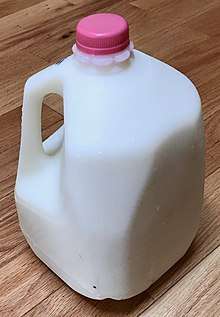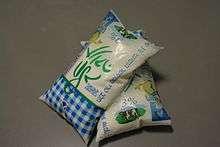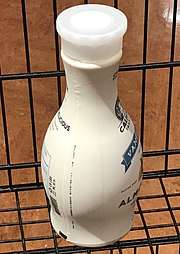Plastic milk container

Plastic milk containers are plastic containers for storing, shipping and dispensing milk. Plastic bottles , sometimes called jugs, have largely replaced glass bottles for home consumption. Glass milk bottles have traditionally been reusable while light-weight plastic bottles are designed for single trips and plastic recycling.
Materials
Packaging of milk is regulated by regional authorities. Use of Food contact materials is required: potential food contamination is prohibited. Strict standards of cleanliness and processing must be followed.
The most common material in milk packaging is high density polyethylene (HDPE), recycling code 2. Low density polyethylene (LDPE), and polyester (PETE), are also in use. Polycarbonate had been considered but had concerns about potential contamination.[1]
Container forms
Blow molded plastic milk bottles have been in use since the 1960s.[2] [3] [4] HDPE is the primary material but polyester is also used. A wide variety of milk bottle designs are available. Some have a round cross section while others have a more square or rectangular shape. A special flat-top square milk jug was recently developed to maximize shipping and storing efficiency but had some difficulties in dispensing. Many milk bottles have integral handles.
Milk bags are also in use. The milk is sold in a plastic bag and put into a pitcher for use.
Small individual containers of milk and cream are often thermoformed or injection molded and have a peelable lid. These are often used in restaurants.
Environmental comparisons
Many potential factors are involved in environmental comparisons of returnable vs non-returnable systems. Researchers have often used life cycle analysis methodologies to balance the many diverse considerations. Often the comparisons show benefits and problems with all alternatives. It helps provide a objective view of a complex subject.[5] [6]
Reuse of bottles requires a reverse logistics system, cleaning and, sanitizing bottles, and an effective Quality Management System. A key factor with glass milk bottles is the number of cycles of uses to be expected. Breakage, contamination, or other loss reduces the benefits of returnables. A key factor with one-way recyclables is the recycling rate: In the US, only about 30-35% of HDPE bottles are recycled.[7]
Examples
.jpg) Individual plastic container of coffee creamer, Japan
Individual plastic container of coffee creamer, Japan 11.5 fl oz , 340 mL, PETE bottle
11.5 fl oz , 340 mL, PETE bottle Plastic Bags of Milk
Plastic Bags of Milk 1.4 L, 48 fl oz PETE bottle
1.4 L, 48 fl oz PETE bottle- Flat-top square jug
References
- ↑ Carwile, J L (2009). "Polycarbonate Bottle Use and Urinary Bisphenol A Concentrations". Environ Health Perspect. 117: 1368–1372. Retrieved 2 October 2018.
- ↑ US3225950A, Josephsen, "Plastic bottle", published 1965
- ↑ US3152710A, Platte, "Plastic milk bottle", published 1964
- ↑ US3397724A, Bolen, "Thin-walled container and method of making the same", published 1966
- ↑ Van Doorsselaer, K; Fox (2000), "Estimation of the energy needs in life cycle analysis of one-way and returnable glass packaging", Packaging Technology and Science: 235–239, doi:10.1002/(SICI)1099-1522(199909, retrieved 11 October 2012
- ↑ Spitzly, David (1997), Life Cycle Design of Milk and Juice Packaging (PDF), U.S. Environmental Protection Agency, retrieved 29 June 2014
- ↑ "2016 United States National Postconsumer Plastic Bottle Recycling Report" (PDF). Association of Plastic Rcyclers. 2017. Retrieved 12 October 2018.
Books, general references
- Yam, K.L., "Encyclopedia of Packaging Technology", John Wiley & Sons, 2009, ISBN 978-0-470-08704-6